Your Shelter Systems’ SolarShed™ Solar Greenhouse Shed will, within 15 minutes of your receiving it, begin to serve you. Start seedlings, overwinter plants, store tools and bikes, dry firewood, etc. Shelter your plants from cold, rain, wind, frost, and birds. Start plants sooner in the spring and keep them growing later in the fall.
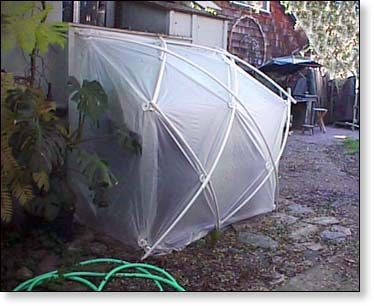
SolarShed Greenhouse Shed is made entirely of translucent greenhouse fabric. The SolarShed is lightweight which means you can move it around easily. Clips with cords are provided to attach your SolarShed Greenhouse Shed to your fence or wall.
Parts List
- Canopy
- SolarShed™ Poles
- Stakes
- Binder clips for doors
Warning: Wear eye protection when setting up your dome. The dome’s poles could break and parts of the pole could fly toward your face. Wear gloves to protect your hands.
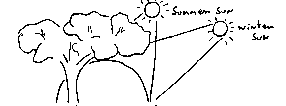
Site selection: Carefully select a site for your SolarShed™. Take time to look around for the best drainage, wind protection, sun and shade exposure, and a level and smooth surface.

Wind: Your SolarShed™ is a lightweight structure, therefore extreme wind sites are not recommended. When possible, avoid exposed hilltops and narrow valleys where wind speed increases. Trees and brush or bales of hay between you and the wind help protect your shelter.

Drainage: Ideal drainage occurs when rainwater can flow down and away from a raised site. Flat land can be improved by building a platform or mounding up a section of ground to set the SolarShed up on. A sloped terrain can be leveled with a platform or by moving earth. This gets your SolarShed onto a flat spot, but a ditch is essential on the uphill side of the SolarShed so run-off water can drain into it, around your floor and on down the hillside.

Floors: An earth floor, as described above, takes less time, energy, and money than a deck. When properly mounded and ditched, an earth floor will remain dry in the worst rains. An earth floor does not require insulation since no cold air can come under the SolarShed.
If you are using your SolarShed as a greenhouse, a floor is not needed. If you are using your SolarShed as a shed, plan to use a waterproof floor. A vapor block keeps the dampness of the ground from entering the space and condensing on the SolarShed’s walls. If you do not purchase a round floor from us, you can make a good floor from the blue rip-stop tarps sold at hardware, building and outdoor supply stores. Black 6 mil. polyethylene tarps will also work but are not as tough.
Assembling Your SolarShed™
When putting up the SolarShed for the first time, wear leather gloves or be careful not to pinch your hands when the poles snap into the connectors. Consider having a friend help you the first time you set up your SolarShed.
Unroll the SolarShed. Spread it out on your prepared site so the SolarShed’s connectors are visible and the uppermost. Take the poles and begin inserting them into the connectors located on the silver top section.
Begin inserting poles into the connectors. Start from one edge, working your way toward the opposite edge. As more poles are added the material will tighten, requiring that you bend the poles and pull the connectors on to the ends of the poles. At each intersection your poles must form a cross.

When under tension the porch wants to form an arch. If you pull on the sides of your SolarShed, you will see that it can “pop” back and forth from a long, narrow tunnel shape to an arch that covers an approximately square area. You will use the square “porch” shape to create your shed.

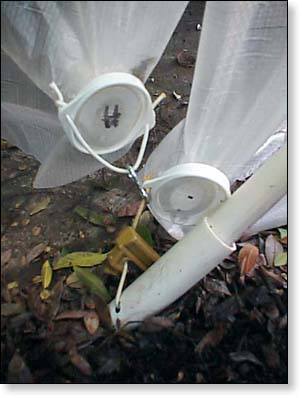
Anchoring:
Your SolarShed is no stronger than its anchors, so anchor it securely. First, screw in the eye screws that we provide or other securing means to the fence or wall at 69″ above the ground . We suggest that you also use a strip of wood with nails or screws to attach the upper edge of the shed covering to your wall or fence. If your wall is not wood, use fasteners made for it.
Next, hook the SolarShed’s doors to the the SolarShed’s covering’s clips. Then, stake the other corner of each of the doors tight to the wall or fence (you can also attach clip with a hook to the wall or fence). Now, stake out the SolarShed’s cover; pulling the covering to tighten the lower skirt of the doors (about 38″).
If the stakes we have provided go into the ground easily, then the type of soil you are situated on requires longer stakes. They can be made from 2″x 2″ lumber with a hole 2″ from the top. Logs or sandbags filled with sand or gravel work also and can even be buried for extra security in soils too loose for your stakes to work. We have even heard of people using metal fence posts. Now, those’re long stakes!
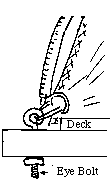
Check your stakes frequently (since ground conditions can change when wet) by pulling on them. You should just barely be able to pull them out.
Two stakes in series is another way to increase holding power against the wind.
CAUTION Snow and Wind:
Remember that the SolarShed is a lightweight, portable structure. Its strength comes from tension, not mass or rigid components. Exposed sites with unusually extreme winds are not recommended. It is apparent that you could not climb on top of the SolarShed, nor can you expect it to support heavy snow loads. Accumulated snow must be melted or shaken off periodically.
Guying:
If you expect strong winds, consider running guy lines out from your SolarShed’s clip cords (not the poles; the poles can be pulled out of the connectors) to trees, stakes, large rocks or buried objects in the soil. In high winds check guys and anchors frequently, adding more if necessary.
Doors:
Hook doors closed when putting up your SolarShed and when staking it out, with the “S” hooks on the corners of each door. This holds the SolarShed in its shape and creates the right spacing at the door openings.
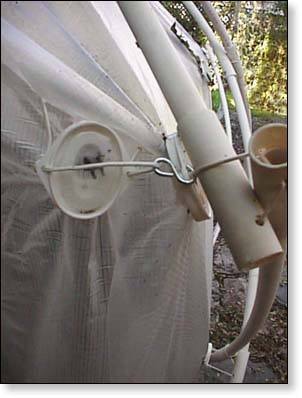 If you’ve adjusted your door openings to the correct width, the doors should seal without a gap when closed.
If you’ve adjusted your door openings to the correct width, the doors should seal without a gap when closed.
Binder clips provided with your SolarShed work great to secure your SolarShed’s doors in wind or when a tight seal is desired. They also work good on net doors. It holds better if you overlap the door and side walk materials a little as you clip them together. If you want more binder clips you can get them at a stationery store.
Floor:
If you plan to use your SolarShed as a shed, install a floor. You can order a floor from us that is cut to shape and includes clips to tie it in or you can use a plastic tarps from a hardware or sporting goods store. Your SolarShed’s floor will keep the dampness of the earth from entering your space and condensing on your walls it will also help keep the things you store inside dry.
Spread the floor out evenly inside the SolarShed. The edge of the floor should go up several inches against the inside of the SolarShed. If you wish to tie in your floor, attach clips a few inches in from the edge of the floor. You will want to clip these on will the floor spread in place so you can match each clip up with a clip that’s around the bottom edge of your SolarShed. Thread string- through one hole on the underside of each floor clip. Then thread it through one hole on the inside of a corresponding dome clip. Pull tight and tie.

Sunshade™ (Optional):
If you need to be cooler inside, you can get an ideal sunshade tarp from us: black on the inside, reflective silver on the outside, with a clip on each comer. If you use your own tarp from the hardware store, use porous gardener’s shade cloth rather than black plastic. (Likewise, you should not reverse your black and silver tarp so that the black side is out). The reason for this is that the sun will heat the black material up too much, causing the poles underneath it to melt and bend.
With clips on the comers of the sunshade, you can tie it to the clip strings on the outside of your SolarShed.
It’s important for sunshades to be kept tight because you need that cooling airspace between it and the SolarShed. If the sunshade material lays on the SolarShed, there is no room for any shade underneath it!
Remove the sun shade to let in the sun’s warmth.
Liner (Optional):
A full liner is available from Shelter Systems. A liner reduces heat loss from radiation, conduction and convection, and creates an insulating dead air space of 2″-3″. It also helps prevents condensation which may occur in very cold situations.
The liner is installed with your SolarShed already set up. Unroll the liner inside the SolarShed. Tie one of your liner top edge cords to the SolarShed’s inner clips. The doors of your liner should line up with the doors of your SolarShed. Inside each clip on your SolarShed there are holes for this purpose. It is only necessary to thread the string through one of the small holes on each clip, not both small holes. Poke the string into a small hole and pull the string back through the big center opening. This is easier if you use a tool like a crochet hook or a needle nose pliers to grip and pull it through.

Now proceed with the rest. Work down from the top, being careful not to miss any clips since it is hard to reach them later on. Pull strings as tight as you can without deforming the dome’s outer cover.
The lower clips at the liner’s edge can be moved if necessary to get the liner nice and tight. Simply unclip them and clip them back on a little higher on the material, adjusting the tension.
Ventilation:
Try to set your SolarShed up under the shade of a tree if you wish it to be cool. If no tree is available, use our SunShade or use greenhouse shade cloth 90% shade. In hot weather keep both SolarShed’s doors open.
Storage:
Brush off all the dirt that you can. Make sure the SolarShed is completely dry. If you have to take the SolarShed down wet, plan to hang it somewhere indoors until it’s dry before packing. Remove stakes and poles. The liner may stay attached in place.
We’ve found the following folding technique to be the easiest. Lay the SolarShed on a dry place. Pull all the SolarShed’s edges so that it fans out and lies flat. Then pleat-fold it. Roll it up until you’ve got a nice bundle.Wrap it in the material you received it in and use strings to hold the roll tight.
Now tie the poles into a bundle. To get it nice and tight, wrap string twice around the bundle of poles and use a packer’s knot. This is a kind of slip knot that holds tight.
Repairs:
Your SolarShed is designed to be durable and problem free. However, some of our customers use their structures for so many years that eventually they need some loving care.

A broken pole can be repaired with a wooden insert such as a piece of a broom handle or a straight stick. They can be replaced with I”, class 200 PVC pipe from a plumbing or building supply store. (Class 125 or schedule 40 will also work).
Broken connectors can be replaced with 3/4″ class 200 PVC.(Class 125 or schedule and some times 40 will also work). Cut them to 5″ in length with any kind of saw, and drill a 1/4″ hole in the center.
The simplest way to repair the fabric is to cut a small square from an inconspicuous place from the material that forms the lower “skirt” of the Solar Shed. If you’d prefer, we’d be happy to send you patch material. This is necessary, of course, if the tear is large. Use silicon rubber glue to glue your patch on the outside or inside of the tear. If the tear is really small you may be able to plug it up with a blob of silicon rubber glue alone.
You can also order whole panels from Shelter Systems. For instance, if a tear is immediately adjacent to a clip, there is too much stress to glue a patch on so it won’t leak, so usually the whole panel needs to be replaced. You can see on your SolarShed where a section can easily be unclipped and a new panel clipped in. This can be done by you or us.
If your SolarShed is flattened by snow, carefully remove the snow without tearing its covering. It is much easier to get your SolarShed back in shape if you remove most of the poles and set the SolarShed up again starting from the center and working out. The stakes do not need to be removed from the ground. Replace any broken poles. Poles can usually be obtained from a building supply or plumbing store. Ask for 1/2″, class 200. Class 125 or schedule 40 will also work. Poles may be ordered from Shelter Systems (send length and size).
If your SolarShed’s site should get a freak storm with extreme winds, consider removing the poles but leaving it staked out. Then run strings back and forth across the SolarShed, going from stake to stake to keep the wind from lifting up on the covering. When the storm passes, put the SolarShed back up.
Applying Grip Clips:
1. Take the male, inner clip part with its flat side facing up and wrap material over it, as shown in drawing ‘B’.
2. Take the larger, female ring and slip it over the covered male part. If you orient the ovals perpendicular to each other, as in drawing ‘C’, when slipping one inside the other, you will not have to force the ring over at all. It should have the cord hole ears upward as shown in drawing ‘C’.
3. Now Turn the female part and so that the male part seats snugly into the locked position.
4. Removal of a clip is just the reverse procedure.
WARNING: Wear eye protection when setting up your SolarShed. The SolarShed’s poles could break and parts of the pole could fly toward your face. Wear gloves to protect your hands.
CAUTION Snow and Wind :
In heavy snow your SolarShed could collapse which could damage what you have in it or compromise your shelter. Do not rely on your SolarShed as your only shelter where it snows.
Your SolarShed will blow away if it is not anchored properly. Study the anchoring instructions carefully and apply all appropriate means to secure your dome to the earth. Rain will soften the ground and greatly reduce the holding power of the stakes. We provide good general purpose stakes, but they cannot cover all ground conditions. Wind will at times come up unexpectedly. Be prepared!
Remember that the SolarShed is a lightweight, portable structure. Its strength comes from tension, not mass or rigid components. Exposed sites with unusually extreme winds are not recommended. It is apparent that you could not climb on top of the dome, nor can you expect it to support heavy snow loads.
Accumulated snow must be melted or shaken off periodically.
Keep all flames and heat away from your SolarShed’s covering and other objects in your SolarShed.
Patented and others pending. [email protected] shelter-systems.com
